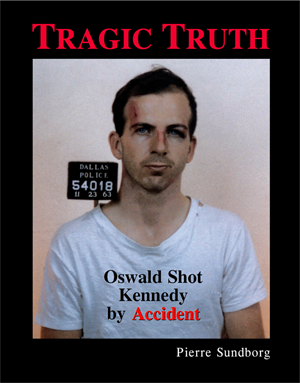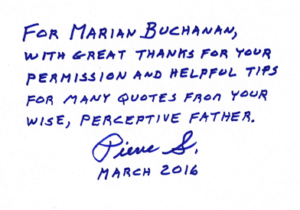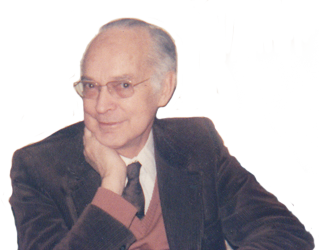
My father, Thomas G. Buchanan, author of Who Killed Kennedy?, is mentioned and quoted in several passages of a new book about the JFK assassination. Tragic Truth
, by Pierre Sundborg, was released in March 2016 and is available on Amazon.
Pierre Sundborg’s assistant contacted me last year to secure copyright permission for quoting passages from my father’s book. I asked if it would also be possible to see what Mr. Sundborg was planning on saying about my father as a context to the quotes, so that I could correct any inaccuracies and misunderstandings.
Pierre Sundborg was very graciously accommodating. As it turned out, the information Mr. Sundborg had on my father prior to our correspondence was gathered from online sources a few years ago, before I sent those sources any corrections. I’m sure there is still some misinformation about my father out there, but readers can be assured that none remains in the published version of Pierre Sundborg’s book (with one very small exception – see my comment after the relevant quote further below).

Pierre Sundborg’s inscription in the complimentary copy of his book “Tragic Truth” that he sent to Marian Buchanan, daughter of author Thomas G. Buchanan.
The author has also been gracious in giving me permission to quote from Tragic Truth for this blog post. I’d like to share not only which passages are quoted from my father’s book, but also what Mr. Sundborg says about my father’s take on the JFK assassination. It is clearly different from his own, since the subtitle of Tragic Truth is “Oswald Shot Kennedy by Accident” whereas my father believed that Oswald was part of a plot to assassinate the President. However, Mr. Sundborg acknowledges my father as one of the few to consider the possibility that the target could have been Connally, which is what Mr. Sundborg believes.
Here, then, are the relevant excerpts from Mr. Sundborg’s book:
From Chapter 8 – Commission, Critics, Rehashes (page 244):
Critics of the Warren Report wrote hundreds of books. The first was in print even before the Warren Report! Thomas G. Buchanan 2007 had been a journalist in Washington, D.C. In 1948, when it became known he was a member of the American Communist Party, he was the first American journalist to be fired solely for his association with that organization.2008 As he continued to be blacklisted in the U.S., he moved to France in 1961.2009 European interest in the shooting of Kennedy was intense in early 1964, when, as a freelancer, he wrote six articles analyzing the assassination. They were published by Paris newspaper L’Express.
Invited to share his theories with the Warren Commission, he was given an interview with Assistant Counsel Howard P. Willens, who asked Buchanan to write down his thoughts. He filed a document with the Commission in March 1964. His book Who Killed Kennedy? was an elaboration of his original articles. It was published in May 1964,2010 six months after the November assassination and four full months before the September Warren Report.
Buchanan explored similarities to the murders of Negro leaders and little black girls, and also looked at length at Communism to discard it as a motive. He then presented and dismissed the idea that Oswald and Jack Ruby were both insane. Remarkably, he included a full page — to my knowledge the very first — on the possibility that Oswald was in fact gunning for Connally. He thought that unlikely, but deserves great credit for being the first to write of the possibility. His thoughts are on page 554 in Chapter 21 – Others On This Trail.
Buchanan was also the first to book-publish a JFK conspiracy theory, and he invented a dandy. With no models to build upon, he involved Oswald (named “Accomplice Three”, who did not fire any shots), two unnamed gunmen “Assassin One” and “Assassin Two” who did, unnamed “Accomplice Four” and “Five” and “Six”, Jack Ruby, and officer J.D. Tippit whose real job was to kill Oswald — but that backfired when Oswald realized what was happening and fired first. The money to fund this huge undertaking came from oil barons (to prevent Kennedy from closing their tax loopholes) and from far-right conservatives (to end his arms reduction negotiations with Soviet premier Nikita Khrushchev). In Texas, both in the 1960s and still today, “far-right” and “oil barons” are not necessarily different groups.
Before publishing its Report, the Commission directed the FBI to investigate all of Buchanan’s claims. In a 10-page report on June 3, 1964, the FBI showed that all 32 claims by Buchanan were unfounded, incorrect or immaterial.2011 Gerald Posner put it without shading: “The FBI, which studied Buchanan’s work, concluded he was responsible for ‘false statements, innuendoes, incorrect journalism, misinformation, and … false journalism,’ and that his book stated as facts items ‘which the Commission’s investigation has disproved completely.'” 2012 While rejecting Buchanan’s conspiracy creations, I admire his thoughtful insights into several matters, and in addition to Chapter 21 – Others On This Trail, have quoted him in Chapters 15 – Regarding Kennedy and 19 – The Shot Not Taken.
From Chapter 9 – Did He Do It? Was It a Conspiracy? (page 275):
In this chapter, Pierre Sundborg quotes Daniel Pipes and his book Conspiracy: How the Paranoid Style Flourishes and Where It Comes From (1997). Here is the quote that mentions my father:
“Yet attention shifted away from Oswald soon after the Kennedy murder, thanks to the work of a network of leftist activists (e.g., Jim Garrison) and book authors both famous (Edward Jay Epstein, Mark Lane) and obscure (Thomas Buchanan, Sylvia Meagher, Harold Weisberg).”
From Chapter 15 – Regarding Kennedy (page 460):
Thomas G. Buchanan in his book Who Killed Kennedy?
“No personal affront had been inflicted on Lee Oswald by the President himself, or by the office that he represented. The United States had given him the money that he asked for, to return from Russia and to bring his wife and family back with him; it had given him a passport to go back there, if it pleased him; nothing Oswald had requested of the government had been denied him.” 3138
“No personal affront had been inflicted on Lee Oswald by the President himself … nothing Oswald had requested of the government had been denied him.”
From Chapter 19 – The Shot Not Taken (page 519):
Pioneer conspiracy theorist Thomas G. Buchanan (Chapter 8) supposed a large crew of conspirators, of whom two were to fire rifles at Kennedy. His “Assassin One” was ahead of the limo, behind the “Grassy Knoll” fence. While Oswald was elsewhere in the Depository, “Assassin Two” was in the sixth-floor far-right window we know so well. Both were to fire simultaneously, when Kennedy became a target from both positions. What did not happen next is illuminating. “So Assassins One and Two were waiting. … And, at last, the presidential car came into view, turned right from Main Street into Houston and was coming straight toward the sixth-floor window of the Texas School Book Depository. If Assassin Two, the man who had been hiding in the stockroom, had been all alone, now was the moment that he would have chosen for his first shot—now, before the car had turned the corner and begun receding. But the moment passed, and Kennedy drove on toward the ambush that [Buchanan says] was waiting.” 3317
Buchanan correctly judged that a shooter’s preferred field of fire would be toward Kennedy as he grew larger in the sight as he approached the TSBD, sitting in plain view, high up in the car, with no trees or traffic signs obstructing the shot. So, Buchanan’s gunman in the window from which Oswald (in the real world) shot, waited only because he had been ordered to hold fire until Kennedy was nearing the Grassy Knoll. The clear, easy, obvious shot was not taken by “Assassin Two” for that reason — and Buchanan deserves credit for noting and (wrongly) explaining the failure to take the easy shot from Oswald’s window.
From Chapter 19 – The Shot Not Taken (page 524):
Buchanan, Thompson, Wecht, McCarthy and Groden believed Oswald was in a conspiracy and had to hold fire until Kennedy could also be targeted by other gunmen.
*** Comment from Marian Buchanan: This is the one mention of my father that Pierre Sundborg forgot to run by me before publishing. I would have suggested an edit, since the sentence, as written, is misleading about my father’s position. While he did believe that “Oswald was in a conspiracy,” he suspected he was an accomplice rather than the assassin, so he did not believe that it was Oswald himself who “had to hold fire until Kennedy could also be targeted by other gunmen,” but rather the unidentified Assassin Two in his theory. However, since this is all explained earlier in the chapter, this slightly misleading wording will likely nevertheless be understood by any reader who has digested those earlier explanations.
From Chapter 21 – Others On This Trail (page 554):
1964 (May): Thomas G. Buchanan in Who Killed Kennedy?
Expatriate American freelance journalist Thomas G. Buchanan wrote a series of articles published by l’Express of Paris to bring the public’s attention to the questions he believed needed to be raised about the conflicting information and official statements that were being reported in the American media. Many Europeans agreed with his take on the matter when trying to make sense of the incomprehensible assassination of the young American President they so greatly admired. As told in Chapter 8 – Commission, Critics, Rehashes, Buchanan then augmented those articles into a slim book, Who Killed Kennedy?, published a full four months before the speedy Warren Report. While considering the possibility that Oswald killed because of insanity, Buchanan wrote this very long paragraph — to my studied knowledge the first in-print footprint (yes, there’s something amiss in that metaphor!) on this trail:“It must be assumed, if there is any merit in the thesis that the murderer of Kennedy was ‘crazy,’ that he was a paranoid who thought that he was being personally persecuted; that, like [assassin of President Garfield] Guiteau, he had nursed some private grievance until it had come to be obsessive, and he felt the only way in which he could avenge the wrong that had been done him was to fire the murder weapon. But since Oswald is the only suspect who has been officially accused, acceptance of this thesis would imply that Kennedy was not the target—that the shots were fired, instead, at Texas Governor John Connally. There has not ever been the slightest indication of a private injury which Oswald felt that he had suffered at the hands of Kennedy himself. Police at Dallas charged, however, that Lee Oswald once had sent a letter threatening the life of Connally, who had been Secretary of the Navy in September, 1959, when Oswald was released from active duty at his own request in order to support his mother. When he subsequently tried to swear allegiance to the Soviet Union, he was given a discharge from the Marine reserves as ‘undesirable,’ as might have been expected.1 The reports first issued were that Oswald had thereafter menaced Connally, feeling his military service had been honorable—as, indeed, it had2—and that his subsequent political decision had no relevance to the performance of his duty while he was in uniform. But when the contents of the letter Oswald wrote in early 1962 to Connally were known, the ‘threats of violence’ turned out to be no more specific than the phrase, ‘I shall employ all means to right this gross mistake or injustice to a bona fide U.S. citizen and ex-serviceman’— hardly the basis for belief that he was planning to assassinate him. A deranged man who was brooding over his rejection by his former military service would have made some effort, on returning to the United States, to rejoin it; but there is no record that he ever tried to do so. Connally, moreover, played no role in the Marines’ decision; he replied to Oswald’s letter that the matter was no longer in his jurisdiction, and that it had been referred to his successor. Any feeling of hostility that Oswald might have had would thus, presumably, have been diverted to the man who ultimately had rejected his request, or to the officer who signed his discharge in the first place. If, by some insane illogic, Connally had been in fact the target, is it likely that the murderer would choose the day when Kennedy was riding in the car beside him, with a huge armed escort; or that, firing three shots, he would hit the wrong man twice?” 3373
To which I respond:
- Mr. Buchanan, you deserve credit for being far ahead of most in even considering the possibility of Connally-as-target.
- You were absolutely correct that Oswald had no complaint whatever against Kennedy.
- Connally was not Secretary of the Navy in 1959; he was appointed to that office in 1961 by newly-elected Kennedy. It’s important to be correct, especially on easy facts.
- Oswald was so disappointed with life in the USSR that he soon realized having been a Marine had been his life’s acme.
- An unhappy malingerer in the Marines, Oswald would not consider rejoining; and if he did, he was sufficiently realistic to realize that the Corps would not want him.
- Isolated in Minsk, he knew only what his mother had written him about the discharge, and had no information on which officer(s) or department(s) had made the change to “undesirable”.
- “[T]he officer who signed his discharge in the first place” had given him an honorable discharge, as proven on the wallet-size discharge card he carried every day from 1959 through November 22, 1963.
- Probably to a large extent, Oswald felt hostility toward Connally because the appeal was for help from a fellow Texan “resident of Ft. Worth as I am.”
- Connally’s terse reply in a campaign envelope with his smiling face framed in a large star was grotesquely memorable, stamping a personal image onto his brusque rejection of Oswald’s plea.
- It is naïve to expect that Oswald would think logically. That was never his manner.
- He shot at Connally the first chance he had — and Kennedy just happened to be sitting there.
- Firing three shots of which the first missed entirely to wound a bystander over a block away, then hitting his target only once and a wrong man twice, is entirely typical of inept Oswald.
1 This was written during the Cold War when all patriotic Americans were expected to be anti-Soviet.
2 Well, no, actually he was a lousy serviceman with a bad record as outlined in Chapter 2 – Marine.
That concludes the quoting of passages from Pierre Sundborg’s book, Tragic Truth: Oswald Shot Kennedy by Accident.
At 764 pages, Tragic Truth is quite a hefty volume, so I haven’t had time to read it all, and therefore can’t provide an in-depth review. I also can’t vouch for the accuracy of all of the information Pierre Sundborg gathered during his research for it, but his diligence in securing copyright permissions, citing his sources, indexing thoroughly, and correcting the information about my father, is a good sign. I hope the excerpts here will help anyone interested in the JFK assassination decide whether to add it to their bookshelf.
At the very least, these excerpts provide an update about what has been published about my father, Thomas G. Buchanan, to whom this website is dedicated.
